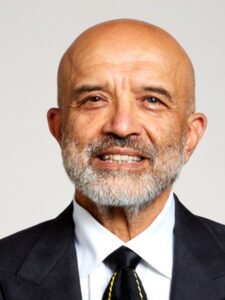Keynote lecture: Vishva Dixit
Chair: Eicke Latz

Vishva Dixit
Genentech, South San Francisco, California, USA
Why so many Ways to Die?
The two key takeaway messages from my talk will be:
- Leaderless cytokines (IL-1a, IL-1b, IL-18, IL-33) are released via GSDMD pores.
- Cell lysis following cell death is not a passive event but one greatly accelerated by NINJ1.
Intracellular lipopolysaccharide (LPS) from Gram-negative bacteria activates caspase-11 causing inflammatory cell death (pyroptosis), IL-1b processing, and lethal septic shock. How caspase-11 drove these downstream signaling events was largely unknown. In 2015, we showed that Gasdermin-D (Gsdmd) is essential for caspase-11-dependent pyroptosis and IL-1b release. Macrophages from Gsdmd–/– mice generated by gene targeting exhibited defective pyroptosis and IL-1b release in response to cytoplasmic LPS or Gram-negative bacteria. Mechanistically, caspase-11 cleaved Gsdmd and the newly generated N-terminal fragment assembled into an oligomeric plasma membrane pore allowing for the release of IL-1b and other leaderless cytokines. At the meeting I’ll also give an update on the most unexpected discovery of a mediator of cell lysis: NINJ1, a transmembrane protein that in dying cells drives the formation of megapores, to accelerate lysis.
Key References
- Kayagaki, N., Warming, S., Lamkanfi, M., Vande Walle, L., Louie, S., Dong, J., Newton, K., Qu, Y., Liu, J., Heldens, S., Zhang, J., Lee, W.P., Roose-Girma, M., and Dixit, V.M. (2011). Non-canonical inflammasome activation targets caspase-11. NatureVol. 479(7371):117-121. [Number of Citations: 2,459]
- Kayagaki, N., Wong, M.T., Stowe, I.B., Ramani, S.R., Gonzalez, L.C., Akashi-Takamura, S., Miyake, K., Zhang, J., Lee, W.P., Muszynski, A, Forsberg, L.S., Carlson, R.W., Dixit, V.M. (2013) Non-canonical inflammasome activation by intracellular LPS independent of TLR4. ScienceVol. 341(6151):1246-1249. [Number of Citations: 1,478]
- Kayagaki, N., Stowe, I.B., Lee, B.L., O’Rourke, K., Anderson, K., Warming, S., Cuellar, T., Haley, B., Roose-Girma, M., Phung, Q.T., Liu, P.S., Lill, J.R., Li, H., Wu, J., Kummerfeld, S., Zhang, J., Lee, W.P., Snipas, S.J., Salvesen, G.S., Morris, L.X., Fitzgerald, L., Zhang, Y., Bertram, E.M., Goodnow, C.C., Dixit, V.M. (2015) Caspase-11 cleaves Gasdermin-D for non-canonical inflammasome signaling. NatureVol. 526(7575):666-671. [Number of Citations: 2,914]
- Kayagaki, N., Kornfeld, O., Lee, B., Stowe, I., O’Rourke, K., Li, Q., Sandoval, W., Yan,Xu, M., Ulas, G., Payandeh, J., Roose-Girma, M., Modrusan, Z., Reja, R., Sagolla, M.,Webster, J., Cho, V., Andrews, T., Morris, L., Miosge, L., Goodnow, C., Bertram, E., andDixit, V.M. (2021) NINJ1 mediates plasma membrane rupture during lytic cell death.Nature, Vol 591:131-136. [Number of Citations: 365]
- Kayagaki, N., Stowe, I.B., Alegre, K., Deshpande, I., Wu, S., Lin, Z., Kornfeld, O.S., Lee, B.L., Zhang, J., Liu, J., Suto, E., Lee, W.P., Schneider, K., Lin, W., Seshasayee, D., Bhangale, T., Chalouni, C., Johnson, M.C., Joshi P., Mossemann, J., Zhao, S., Ali, D., Godenberg, N.M., Sayed, B.A., Steinberg, B.E., Newton, K., Webster, J.D., Kelly, R.L., Dixit, V.M. (2023) Inhibiting membrane rupture with NINJ1 antibodies limits tissue injury. Nature, Vol. 618:1072-1077.
Biosketch
A pathologist by training, Dr. Vishva M. Dixit has studied molecular mechanisms that underlie cell death and inflammatory signaling. In particular, he is known for the breakthrough discovery that a cysteine protease (caspase) is a component of the death receptor-induced apoptotic pathway – a finding that allowed his laboratory and others to then elucidate the entire ‚death cascade‘. Born in Kenya, he went to medical school at the University of Nairobi and, after clinical work at the Kenyatta National Hospital, pursued a residency in Pathology at Washington University in St. Louis. He joined the Department of Pathology at the University of Michigan in 1986 and rose through the ranks to Professor. In 1997, he left to join Genentech where he is presently Vice President of Research. He is a member of the National Academy of Sciences, the National Academy of Medicine, the American Academy of Arts and Sciences and a Foreign Member, European Molecular Biology Organization. In 2021 he was elected a Foreign Member of the Royal Society as well as a Foreign Member of The Royal Netherlands Academy of Arts and Sciences. In 2022, he received the Heineken Prize for Medicine and the Vilcek Prize in Biomedical Science. He serves on the HHMI Medical Advisory Board as well as on the External Scientific Advisory Group at the Bill and Melinda Gates Foundation.
